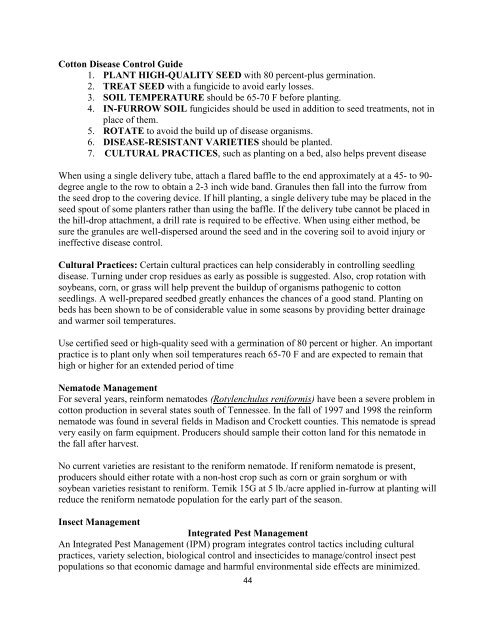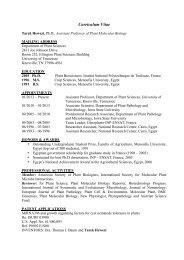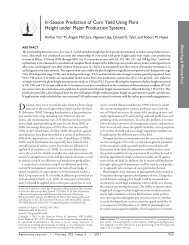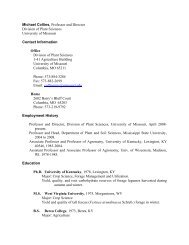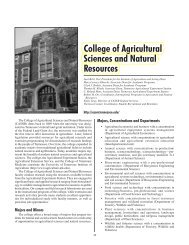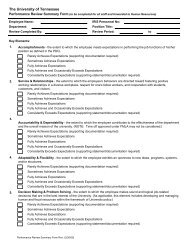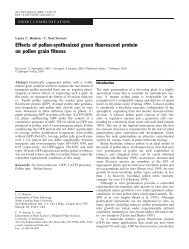CATEGORIES OF FORAGE CROPS - Department of Plant Sciences
CATEGORIES OF FORAGE CROPS - Department of Plant Sciences
CATEGORIES OF FORAGE CROPS - Department of Plant Sciences
You also want an ePaper? Increase the reach of your titles
YUMPU automatically turns print PDFs into web optimized ePapers that Google loves.
Cotton Disease Control Guide<br />
1. PLANT HIGH-QUALITY SEED with 80 percent-plus germination.<br />
2. TREAT SEED with a fungicide to avoid early losses.<br />
3. SOIL TEMPERATURE should be 65-70 F before planting.<br />
4. IN-FURROW SOIL fungicides should be used in addition to seed treatments, not in<br />
place <strong>of</strong> them.<br />
5. ROTATE to avoid the build up <strong>of</strong> disease organisms.<br />
6. DISEASE-RESISTANT VARIETIES should be planted.<br />
7. CULTURAL PRACTICES, such as planting on a bed, also helps prevent disease<br />
When using a single delivery tube, attach a flared baffle to the end approximately at a 45- to 90-<br />
degree angle to the row to obtain a 2-3 inch wide band. Granules then fall into the furrow from<br />
the seed drop to the covering device. If hill planting, a single delivery tube may be placed in the<br />
seed spout <strong>of</strong> some planters rather than using the baffle. If the delivery tube cannot be placed in<br />
the hill-drop attachment, a drill rate is required to be effective. When using either method, be<br />
sure the granules are well-dispersed around the seed and in the covering soil to avoid injury or<br />
ineffective disease control.<br />
Cultural Practices: Certain cultural practices can help considerably in controlling seedling<br />
disease. Turning under crop residues as early as possible is suggested. Also, crop rotation with<br />
soybeans, corn, or grass will help prevent the buildup <strong>of</strong> organisms pathogenic to cotton<br />
seedlings. A well-prepared seedbed greatly enhances the chances <strong>of</strong> a good stand. <strong>Plant</strong>ing on<br />
beds has been shown to be <strong>of</strong> considerable value in some seasons by providing better drainage<br />
and warmer soil temperatures.<br />
Use certified seed or high-quality seed with a germination <strong>of</strong> 80 percent or higher. An important<br />
practice is to plant only when soil temperatures reach 65-70 F and are expected to remain that<br />
high or higher for an extended period <strong>of</strong> time<br />
Nematode Management<br />
For several years, reinform nematodes (Rotylenchulus reniformis) have been a severe problem in<br />
cotton production in several states south <strong>of</strong> Tennessee. In the fall <strong>of</strong> 1997 and 1998 the reinform<br />
nematode was found in several fields in Madison and Crockett counties. This nematode is spread<br />
very easily on farm equipment. Producers should sample their cotton land for this nematode in<br />
the fall after harvest.<br />
No current varieties are resistant to the reniform nematode. If reniform nematode is present,<br />
producers should either rotate with a non-host crop such as corn or grain sorghum or with<br />
soybean varieties resistant to reniform. Temik 15G at 5 lb./acre applied in-furrow at planting will<br />
reduce the reniform nematode population for the early part <strong>of</strong> the season.<br />
Insect Management<br />
Integrated Pest Management<br />
An Integrated Pest Management (IPM) program integrates control tactics including cultural<br />
practices, variety selection, biological control and insecticides to manage/control insect pest<br />
populations so that economic damage and harmful environmental side effects are minimized.<br />
44


